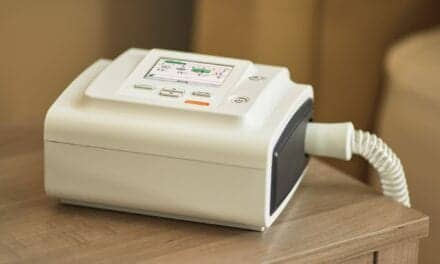Confusion, rather than consensus, has been the rule when it has come to establishing acceptable, NPPV reimbursement criteria
Given the reports in the trade press, it is no wonder there is a great deal of misunderstanding and misinformation swirling about the respiratory care community regarding the use of noninvasive positive pressure ventilation (NPPV) in the home.
To my mind, one of the most glaring examples of misinformation appeared in the October 1998 issue of HME News. The commentary explicitly states that the pulmonary medicine community strongly supports the draft NPPV policy proposed by the Durable Medical Equipment Regional Carrier (DMERC) medical directors this summer. Both the National Association for Medical Direction of Respiratory Care (NAMDRC) and the American College of Chest Physicians (ACCP), however, took issue with many of the specific proposals contained in the policy, particularly the proposal to limit NPPV prescriptions to pulmonologists only.
NAMDRC becomes involved
NAMDRC’s involvement with NPPV in the home began in spring 1997 after one of our members informed us that a local supplier was trying to move one of his patients on to NPPV. According to the letter, once the supplier learned the physician, a pulmonologist, was making specific inquiries as to the clinical indications warranting NPPV, the supplier lost interest.
Recognizing that the best solution to such a scenario is to get as much information as possible, the NAMDRC Executive Office discreetly contacted the Health Industry Manufacturers Association (HIMA), as well as two major device manufacturers, to discuss the issues raised by the letter. These players attempted to determine the accuracy of the information, the extent to which such marketing efforts existed regionally or nationwide, and the true clinical indicators that would warrant NPPV in the home.
Not surprisingly, the DMERC medical directors contacted NAMDRC in October 1997, asking for informal assistance in identifying the clinical circumstances under which we believed NPPV was warranted in the home. Working under an extremely tight deadline, NAMDRC, in consultation with experts in the field, submitted a framework for the DMERC medical directors to consider in their efforts to establish a specific coverage policy for NPPV. The more we thought about the information we provided the DMERC medical directors, however, the more uncomfortable we felt.
In response to our uneasiness, we explored the possibility of coordinating a multidisciplinary consensus conference to create guidelines correctly. Funding was provided by HIMA and the American Thoracic Society; the ACCP, the American College of Physicians, the American Sleep Disorders Association, the American Academy of Family Physicians, the American Academy of Homecare Physicians, and the American Association for Respiratory Care were all invited to send participants to the conference. Additionally, more than 30 observers were invited to attend to represent the manufacturing, supplier, and provider communities. All four DMERC medical directors were also invited, as were the National Institutes of Health and the Health Care Financing Administration.
The conference was held in February, with observers given the opportunity to speak on subjects raised at the conclusion of each formal presentation. Work groups were created, including participants and observers, to address the development of specific clinical criteria for three major categories: neuromuscular disorders, chronic obstructive pulmonary disease (COPD), and nocturnal hypoventilation. By the conclusion of the conference, the broad outlines of three sets of clinical indicators were agreed upon by conference participants.
During the next several months, conference participants continued to refine those clinical criteria, and each segment was accompanied by a detailed narrative to explain the clinical basis for the recommendations made by the consensus conference participants. After countless incarnations and dozens of revisions and compromises, a final document was approved.
Running somewhat parallel to the consensus conference track was the practical effort by the DMERC medical directors to establish a coverage policy for NPPV in the home, a policy that would, by definition, limit the availability of the therapy and thereby control Medicare expenditures. Consensus conference participants recognized that their primary goal was to provide a clinically concise document for the medical community, while the DMERC medical directors needed to promulgate guidelines with reasonable, supportable limits to NPPV coverage and payment.
Last summer, the DMERC medical directors released their proposed policy for comment. Among the more controversial recommendations were:
- a proposal to require a pulmonologist to prescribe NPPV;
- a proposal to require a patient receiving NPPV to have the same physician (pulmonologist) write the NPPV prescription and the home oxygen prescription;
- a proposal to conduct a sleep study for all patients who would come under the COPD diagnostic category;
- a proposal that named sleep apnea patients rather than nocturnal hypoventilation patients as the third category of patient eligible for NPPV.
There was a strong outcry from the supplier and device manufacturing community affected by the proposed policy. The comments ranged from the productive and constructive to the outright hostile and angry. The NAMDRC leadership was not as surprised by the specifics of the DMERC proposal as it was by the overwhelming astonishment the nonmedical community expressed over the proposal. The NAMDRC leadership knew that it would address in detail its numerous concerns regarding the DMERC proposal, but was also fascinated by the response simply because we believed that anyone who attended the 2-day consensus conference would certainly have known the direction that the initial proposed policy from the DMERC medical directors would take.
Although there are certainly areas of major disagreement, NAMDRC recognized that the DMERC coverage policy was aimed at addressing their legitimate concerns, not necessarily the parameters of clinical indicators identified by conference participants. For example, some conference observers believed that every COPD patient might benefit from NPPV–all 16 million people with COPD! After considering simple taxpayer and Medicare economics, any thoughtful person would know that, regardless of the medical efficacy of NPPV, the DMERC medical directors could not responsibly promulgate a coverage policy that could lead to a 30% 400increase in overall Medicare expenditures for one new therapy.
Conclusion
The role of organizations such as NAMDRC ought to be to give policymakers information to be able to make reasonable decisions. NAMDRC recognized that the information we had provided more than a year ago was inadequate and not really justifiable from a clinical perspective. A broader, multidisciplinary perspective was required. Whether the DMERC medical directors modify their proposal to reflect the findings of the February 1998 consensus conference remains to be seen. Both NAMDRC and the ACCP have written virtually identical comments to the DMERCs urging changes in the proposed NPPV policy. It is through cooperative efforts rather than confrontational approaches that effective, reasonable policies are drafted, edited, and finalized. Although the chapter on NPPV is closed, we are confident that the DMERC medical directors will promulgate a reasonable, workable policy that will satisfy the medical community because it will be based on the clinical criteria established by the consensus conference. In the meantime, the final report of the NAMDRC consensus conference awaits publication.
Phillip Porte is the Executive Director of the National Association for Medical Direction of Respiratory Care, Chevy Chase, Md. r









